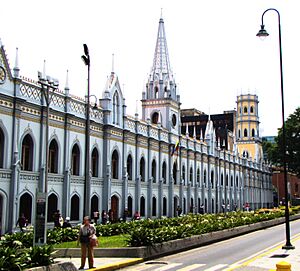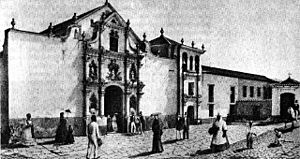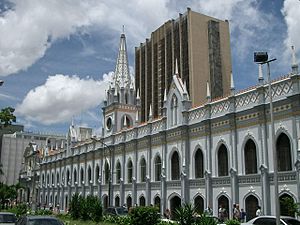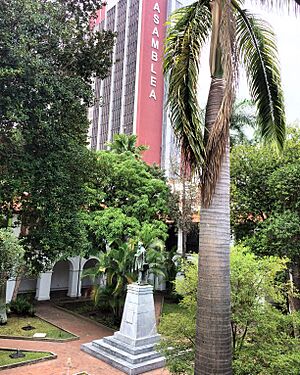Palacio de las Academias facts for kids
The Palacio de las Academias (which means Palace of the Academies) is a grand building in the center of Caracas, Venezuela. It looks like an old castle because it's built in a style called Neo-Gothic. This building has a long history, starting as a Franciscan convent way back in 1684.
Over the years, it was used for many different things. It was a military barracks, a hospital, and even a college. In 1876, the University of Caracas moved into the building. Its old look was changed to the Neo-Gothic style we see today. After the university moved to a new campus in 1952, the building became home to several important National Academies. In 1965, it was recognized as a national monument. Today, the Palacio de las Academias houses six National Academies. These include groups for history, language, medicine, political science, law, and science.
Contents
Where to Find the Palace
The Palacio de las Academias is located right in the middle of Caracas. You can find it at the corner of Avenida Universidad and La Bolsa. It's easy to get there using the metro system. Just get off at the Capitolio or El Silencio station. The Church of San Francisco is right next to the palace. It was built as part of the original convent.
A Look at Its History
The building started as the Convent of San Francisco. It was one of the first convents built in the Caracas area. It was founded in 1576 and finished within ten years. At first, Franciscan friars lived there. Later, in 1597, it was taken over by Dominicans. By 1673, regular people could study in its classrooms.
An extra building was added in 1794. However, it was damaged during a big earthquake in Caracas in 1812. By the 1820s, Caracas had about 40 convents. The National Library was even located in this convent by 1835.
The building got its new, grand look in 1876. This happened during the time of President Antonio Guzmán Blanco. It was first known as the San Francisco Convent. Then it became the Central University of Venezuela. Later, people called it the Biblioteca, or Central Library. Since the time of President Pérez Jiménez, it has been known as the Palace of the Academies.
Building Style and Inside Features
When the building was updated in 1876, many changes were made. A new courtyard was added on the south side. The front of the building was made longer. The inside rooms were also completely redone. Architects Luis Soriano and Carlos Toro Manrique led these changes.
The updates gave the building its Neo-Gothic style. You can see tall, pointed spires above the many windows. A central clock tower was also added. It stands tall at about 35 meters (115 feet).
The Main Hall
The university's main auditorium is called the paraninfo. It's a very fancy hall on the north side of the building. This hall was opened in 1876. It has three main tables and a special raised platform. This platform has a lectern under a beautiful velvet canopy. Everything in the room is in the Gothic Revival style.
The hall also displays 21 portraits and two busts (sculptures of heads and shoulders). These show famous people. Some important paintings include:
- Simón Bolivar by Martín Tovar y Tovar (1875)
- Pope Innocent XIII (artist unknown)
- Archbishop Francisco de Ibarra (1726–1806) by José de la Merced Rada (1830)
- Bishop Diego de Baños y Sotomayor (1637–1706) also by Merced Rada
- Philip V of Spain (artist unknown)
Other paintings show people who helped Venezuela's culture and government. These include the writer Miguel José Sanz, the scholar Andrés Bello López, the explorer Alexander von Humboldt, the scientist Adolf Ernst, and President José María Vargas.
See also
 In Spanish: Palacio de las Academias para niños
In Spanish: Palacio de las Academias para niños





